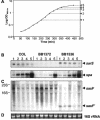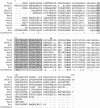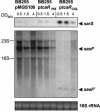TcaR, a putative MarR-like regulator of sarS expression
- PMID: 15126456
- PMCID: PMC400606
- DOI: 10.1128/JB.186.10.2966-2972.2004
TcaR, a putative MarR-like regulator of sarS expression
Abstract
TcaR, which shares sequence homology with MarR-like transcriptional regulators, has been identified as a novel Staphylococcus aureus regulator affecting the expression of the global regulatory element SarS (SarH1), as well as that of the cell surface-associated protein SasF (N315-SA2439). Microarray analysis, confirmatory Northern blots, and genetic complementation experiments showed that TcaR upregulates sarS and thus spa transcription. In addition, it attenuates whole-length transcription of sasF, thereby producing a truncated transcript lacking the 3' terminus, which codes for the cell wall anchor motif. Hence, in strains containing an intact tcaR gene, TcaR is likely to decrease the amount of the surface-associated protein SasF and to increase that of the surface-associated protein A. The widely used laboratory strains derived from NCTC8325 were found to be natural, truncated mutants of tcaR, harboring an inactive TcaR and therefore expressing very low levels of sarS. The data presented here identified TcaR as a further activator of sarS, and a modulator of sasF expression that has to be taken into account in studies of virulence gene expression in S. aureus.
Figures






References
-
- Alekshun, M. N., S. B. Levy, T. R. Mealy, B. A. Seaton, and J. F. Head. 2001. The crystal structure of MarR, a regulator of multiple antibiotic resistance, at 2.3 Å resolution. Nat. Struct. Biol. 8: 710-714. - PubMed
-
- Arvidson, S., and K. Tegmark. 2001. Regulation of virulence determinants in Staphylococcus aureus. Int. J. Med. Microbiol. 291: 159-170. - PubMed
Publication types
MeSH terms
Substances
LinkOut - more resources
Full Text Sources
Molecular Biology Databases
Miscellaneous

